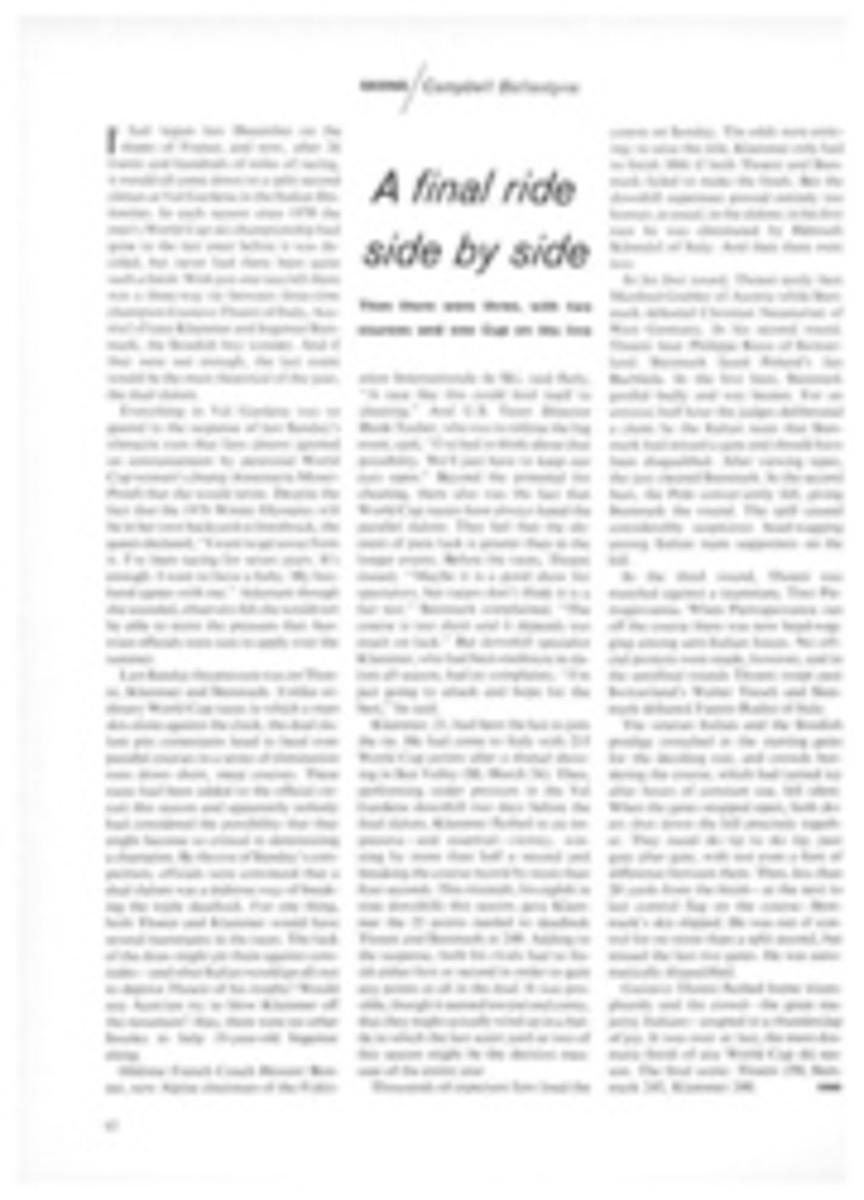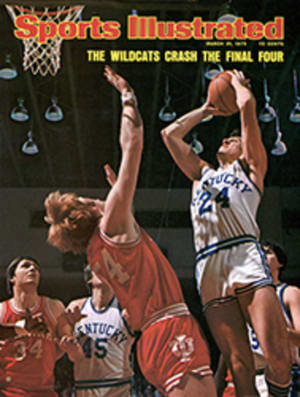
NAIAD AGNES PLUNGED WOMEN INTO SPECTATOR SPORTS 100 YEARS AGO
Since this year marks the centennial of women's participation in modern spectator sports, it would be unfair to deny a word of recognition to the young lady who started it all.
Before 1875, women took part in sports, but usually in comparative privacy. As early as the 16th century, Mary Queen of Scots lost her head over golf as well as politics, while in the 18th century England's Queen Anne had a passion for horse racing. But it was not until 14-year-old Alice Agnes Beckwith jumped into the Thames 100 years ago that a woman raised—or lowered—herself to the level of public jock.
The idea that she was an innovator probably never occurred to Agnes, who had been swimming under the tutelage of her older brother William. He challenged and often defeated champion swimmers of England, and Agnes saw no reason to deny herself similar glory just because she was a woman.
Since there was a lack of feminine competition, Agnes began by testing her skill and endurance against the Thames. "Miss Beckwith left London Bridge yesterday afternoon to swim to Greenwich, a distance by water of about six miles," a London paper of Sept. 1, 1875 reported. "For a powerful man the feat may not be an over-difficult one; but it is a test of some endurance for a slight young girl like the performer of yesterday." After slightly more than an hour in the water, she arrived at Greenwich where "she was greatly cheered."
Agnes' glory was short-lived. Less than a week later another young woman, Emily Parker, swam from London Bridge to Blackwall, nearly two miles farther than Agnes had gone. "During the progress down the river, pistols and small cannon were fired from various points, and the sailors in the ships cheered as the swimmer and the river mob which followed went past," reported the London Standard.
News of Agnes, Emily and subsequent "natatory events" soon reached America where it was brushed aside as a temporary form of mass insanity. "We hear of one young lady 14 years of age swimming five miles down the Thames," remarked The New York Times on Sept. 27, 1875. "Within a week another equally young lady outbids her for popular favor by swimming seven miles in the same river, and immediately a subscription is raised to present her with a gold medal. Then two ladies swim from Shore-ham to Brighton, a distance of six miles; then a barman and a barber join hands on one Sunday after church, and, jumping off London Bridge, swim to Greenwich; then a man jumps off Westminster Bridge; and another off Cannon Street Bridge....It would almost seem that a large number of the people in that country just now are engaged either in jumping off bridges and performing swimming feats, or in contemplating them."
The barbers and barmen soon faded from view, but for Agnes public swimming had become a way of life. Less than a year later she covered the 10 miles from Chelsea to Greenwich Pier while adding a touch of show biz to her act. As she passed beneath the Vauxhall Bridge "she several times passed her body through a hoop—a feat which elicited a special cheer," reported the London Echo.
Four years later Agnes turned up in the whale tank of the Royal Aquarium at Westminster to prove that she could stay afloat for 30 hours. Said the Standard, "It was as refreshing as it was interesting to witness this graceful young 'Naiad,' clad in her costume du bain of black silk trimmed with crimson, disporting herself in her aqueous abode."
England's interest in Agnes' act soon palled, but the ever-resourceful Beckwith siblings hired an overseas manager and sailed for America. The City of Berlin deposited them in New York in early June 1883, where they were lionized.
Their act was a more elaborate version of the Westminster stay-afloat marathon. First William dived underwater and devoured two sponge cakes without coming up for air. Then he drank a bottle of milk and smoked a pipe beneath the surface. Spectators at the Natatorium on 45th Street were impressed. "In fact, it would seem that he might as well stay under altogether, for if a man can eat, drink, and smoke underwater during the hot weather New York is at present experiencing, it is folly to come above the surface to be roasted," reported The New York Times.
Agnes' role was much more artistic. Clad in flesh-colored tights and a very décolleté bodice, she walked in the water with her hands above her head and performed a routine known as "the prayer" by swimming with her feet while holding her hands clasped above her head. "This style of swimming," remarked the Times, "is recommended for steamboat collisions and ocean wrecks, as it gives one an opportunity to pray for help while he or she paddles shoreward."
Later that month Agnes decided to crown her American visit with an exhibition of endurance swimming from Sandy Hook, N.J. to Rockaway Beach, N.Y., a distance of about 20 miles. The swim began shortly before 9 a.m. on June 30, 1883, Agnes emerging from the cabin of the steam launch Bonnie Doon and diving overboard. The steamer Sylvester soon appeared on the scene loaded with 300 excursionists as well as a fife and drum corps.
For a while all went well. Swimming at 24 strokes per minute, Agnes made steady progress until 11:30, when she paused to drink a cup of beef tea. About noon, the wind picked up and dark clouds ominously appeared. "Half an hour later, they burst, amid thunder and lightning, and poured torrents of rain upon her, as well as upon a dozen of seasick men who were distributed in attitudes of distress about the deck of the launch," reported The New York Sun.
After struggling for an hour without making noticeable headway, Agnes relaxed to await a change in the conditions. But the storm continued. Much against her will, she was taken from the water shortly before two o'clock.
"This is a swindle," she said angrily, accusing the pilot of the launch of not knowing the tides. Swimming with the sea instead of against it would have been a simple task even in the stormy weather, she maintained. As it was, she had made three-quarters of the distance before having to board the boat, a feat that New Yorkers accepted with appreciation and generosity.
Agnes Beckwith slipped into obscurity soon afterward, but she had demonstrated that participation in spectator sports need not be the monopoly of men.

